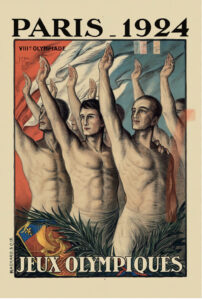 As we enjoy the pageantry and competition of the 2024 Olympics, a look back to the last time Paris hosted yields a look at just how much time has passed and what it would have been like to attend this event in the Roaring Twenties.
As we enjoy the pageantry and competition of the 2024 Olympics, a look back to the last time Paris hosted yields a look at just how much time has passed and what it would have been like to attend this event in the Roaring Twenties.
The 1924 Summer Olympics, the Games of the VIII Olympiad, marked a significant moment in sports history. Returning to Paris for the second time, the first in 1900, these Games showcased athletic prowess and highlighted the evolving culinary landscape of the Roaring Twenties. Let’s embark on a gastronomic journey through time, exploring the dishes that fueled athletes and delighted spectators during this golden age of sports and cuisine.
Paris in the Roaring Twenties
The 1924 Olympics occurred during a vibrant era known as the Roaring Twenties. Paris was at the heart of this cultural renaissance, with its bustling cafés, jazz clubs, and avant-garde art scene. This energy and innovation extended to the culinary world, influencing the food served during the Games.
Popular Dishes of 1924
- Boeuf à la Mode: This classic French beef dish braised in red wine remained a staple, providing hearty nourishment for athletes and spectators alike.
- Sole Meunière: A simple yet elegant dish of sole fish dredged in flour and cooked in butter, popularized by the trend of lighter, more refined cuisine.
- Poulet à la King: A creamy chicken dish that gained international popularity, reflecting the growing American influence on French cuisine.
- Crêpes Suzette: This dramatic dessert, often prepared tableside with a flambé of orange-flavoured liqueur, epitomized the theatrical dining experiences of the era.
- Salade Niçoise: A refreshing salad from the French Riviera, perfect for summer dining during the Games.
Culinary Innovations of the 1920s
The 1924 Olympics coincided with several culinary innovations that would have been showcased during the event:
- Refrigeration: Improved refrigeration technology improved food preservation and chilled dish serving.
- Canned Foods: The popularity of canned goods increased, offering convenience and variety to visitors worldwide.
- Cocktail Culture: The prohibition era in the United States led to a booming cocktail scene in Paris, with new drinks invented and enjoyed.
International Influences
As an international event, the 1924 Olympics brought together diverse culinary traditions:
- American Sandwiches: Quick and portable sandwiches became popular as convenient meals for spectators.
- Colonial Cuisine: France’s colonial ties introduced new ingredients and flavours from Africa and Asia.
- Italian Pasta: The growing popularity of Italian cuisine saw pasta dishes appearing on more Parisian menus.
Beverages of the 1924 Olympics
- Champagne: The quintessential French celebratory drink, perfect for toasting athletic victories.
- Aperitifs: Drinks like Dubonnet and Lillet gained popularity as pre-dinner drinks.
- Coffee: Parisian café culture remained strong, with spectators and athletes enjoying espresso and café au lait.
The Olympic Village and Dining
The 1924 Games introduced the first Olympic Village, located in Colombes. This new concept brought with it centralized dining facilities for athletes, offering:
- Balanced Meals: Nutrition for athletes became a focus, with meals designed to provide energy and aid recovery.
- International Options: The village aimed to cater to athletes’ dietary needs and preferences from various countries.
- Communal Dining: The village fostered a sense of community among athletes through shared meal times.
Culinary Legacy of the 1924 Olympics
The 1924 Paris Olympics left a lasting impact on the culinary world:
- It showcased French cuisine globally, further cementing Paris’s reputation as a gastronomic capital.
- The event highlighted the importance of nutrition in athletic performance, influencing future approaches to sports dining.
- The international exchange of culinary ideas during the Games contributed to the ongoing evolution of French cuisine.
The 1924 Paris Olympics were a celebration of athletic achievement and a showcase of culinary excellence. From traditional French dishes to innovative new creations, the food of the Games reflected the dynamic spirit of the Roaring Twenties. As we look back on this golden era of sports and gastronomy, we can appreciate how the culinary landscape of the 1924 Olympics laid the foundation for the diverse and nutrition-focused approach to food at modern Olympic events.
Whether you’re a food enthusiast, a history buff, or an Olympic fan, the culinary story of the 1924 Games offers a unique window into a transformative period in both sports and gastronomy. As we continue to celebrate Olympic traditions, the flavours of 1924 Paris remind us of the rich heritage that connects food, culture, and athletic excellence.

